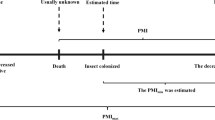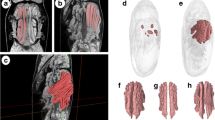Abstract
A forensic entomology case is presented which is interesting for two reasons; firstly, it uses egg development, but secondly, it involves a case which is over 20 years old, and was recently re-opened. The only entomological evidence was in the form of photographs. Usually, it is not possible to make any determinations from photographs alone, as species and age cannot be determined. However, this case was particularly unusual, as close up photographs taken by police at the crime scene showed the first egg eclosion. Weather records, developmental data and degree day accumulations, together with a knowledge of local species and their habitats, allowed determination of the time since death. Time of death was affirmed when the defendant was convicted of first degree murder more than 20 years after the killing.
Similar content being viewed by others
References
Henssge C, Madea B, Knight B, Nokes L, Krompecher T (1995) The estimation of the time since death in the early postmortem interval, 2nd edn. Arnold, London
Anderson GS, VanLaerhoven SL (1996) Initial studies on insect succession on carrion in southwestern British Columbia. J Forensic Sci 41:617–625
Nuorteva P (1977) Sarcosaprophagous insects as forensic indicators. In: Tedeschi CG, Eckert WG, Tedeschi LG (eds) Forensic medicine : a study in trauma and environmental hazards. Saunders, Philadelphia, pp 1072–1095
Anderson GS (2000) Minimum and maximum developmental rates of some forensically significant Calliphoridae (Diptera). J Forensic Sciences 45:824–832
Dillon LC, Anderson GS (1995) Forensic entomology: the use of insects in death investigations to determine elapsed time since death. Canadian Police Research Centre. Technical Report TR-05-95
Anderson GS (2001) The history of forensic entomology in British Columbia. J Entomol Soc BC 98:129–138
Anderson GS (2001) Insect succession on carrion and its relationship to determining time of death. In: Byrd JH, Castner JL (eds) Forensic entomology. The utility of arthropods in legal investigations. CRC Press, Boca Raton, pp 143–175
VanLaerhoven SL, Anderson GS (1999) Insect succession on buried carrion in two biogeoclimatic zones of British Columbia. J Forensic Sci 44:32–43
VanLaerhoven SL, Anderson GS (1996) Forensic entomology. Determining time of death in buried homicide victims using insect succession. Canadian Police Research Centre. Technical Report TR-02-96
Author information
Authors and Affiliations
Corresponding author
Rights and permissions
About this article
Cite this article
Anderson, G.S. Determining time of death using blow fly eggs in the early postmortem interval. Int J Legal Med 118, 240–241 (2004). https://doi.org/10.1007/s00414-004-0443-6
Received:
Accepted:
Published:
Issue Date:
DOI: https://doi.org/10.1007/s00414-004-0443-6




